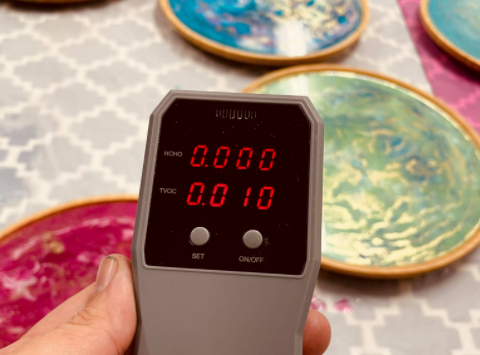Measuring VOC's in our classes - why we do it, and where you can find our recordings
- Jaana brown

- May 5, 2021
- 3 min read

As part of our continued assurance regarding our compliance to the SDS recommendations for ventilation and to back up our claims that we provide adequate ventilation in classes, we have taken our commitment one step further and have decided to create a record of our TVOC samples across our network.
As a business that supplies resin art classes, the safety of our clients are paramount and so we have created this post, which will be added to by the regional managers across our network as they spot check their regions venues each month thus supporting our risk assessments regarding ventilation in classes and our choice not to use paper masks (and not to torch unless rubber masks can be provided).
What is a VOC?
This is a question that gets thrown around frequently in classes. Many people going into classes will ask us what the VOC levels are on our resin. What most don't know is what a VOC actually is and why its important to check them. VOCs are an acronym for Volatile Organic Compounds and are organic chemicals that become a gas at room temperature. These are the main origin of air pollution at ground level. A common term used when measuring and eliminating VOCs is “Total VOC” or TVOC.
TVOC means the total concentration of multiple VOCs present simultaneously in the air. Measuring TVOC concentrations is a common measurement taken into account when it comes to air pollution.
What are acceptable levels of TVOCs?
Low TVOC concentration levels is considered to be less than 0.3 mg/m3. Acceptable levels of TVOC ranges from 0.3 to 0.5 mg/m3 of concentration. From 0.5 mg/m3 of TVOC concentration level onwards, the concern is considered to be considerable or high.
TVOC can be measured in micrograms per cubic meter (µg/m3) of air, milligrams per cubic meter (mg/m3), parts per million (ppm) or parts per billion (ppb).
In the below chart, we’re showing acceptable VOC levels in the air we breathe:
TVOC Level mg/m3 - Level of Concern
Less than 0.3 mg/m3 Low
0.3 to 0.5 mg/m3 Acceptable
0.5 to 1 mg/m3 Marginal
1 to 3 mg/m3 High
What are VOC's and where do we find them?
The most common VOCs present in the air we breathe are:
Acetone, Arsine, Benzene, Ethylene glycol, Formaldehyde, Hydrogen sulfide, Methylene chloride, Nitric oxide, Styrene, Tetrachloroethylene, Toluene, and Xylene
In industrial processes, VOCs are generated whenever there is an application of solvents, alcohols and paints. In other words, that is basically in the chemical, petrochemical, automotive and pharmaceutical sectors.
That means that in our everyday life, we are in continuous contact with several products that contain and emit VOCs. For instance, semi-conducting materials, pill capsules, disinfectants, synthetic rubber, vehicle exhaust, auto parts, stored fuel, paint solvents, silicone sealers, printing ink, adhesives, paints and varnishes. Resin also has a level of VOC's associated with its use and during cure.
How Sip 'n' Dip measures VOC's
Our Regional Managers are provided with a TVOC Real-Time Air Quality Tester and asked to visit each of their venues once a month to test the air quality and provide a recording of the air quality sampled, during class just after the chemicals are decanted, combined and starting their chemical reaction (at the time that you would expect VOC levels to be at their peak) and to provide head office with that recording. If the recording breaches safe levels, the venue requires an out of cycle on-site risk assessment. We are happy to say that this has never happened but the process exists as a safeguard for our clients.
In the comments of this blog you can find the TVOC measurements submitted from the regional managers each month for their venues ongoing from the date this blog goes live, onewards.
For questions, please refer to our resin FAQ page located here.












I was impatiently searching for this software, Finally i got it. You may check it out.
https://toolforpc.com/
https://patchfullkeygen.com/
https://softwarespanda.com/
https://softkeytools.com/
GOODNA STUDIO 05/05/21 CLASS OF 18